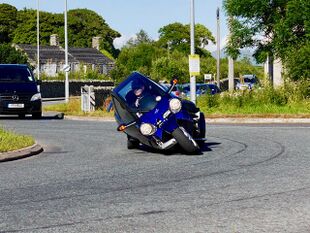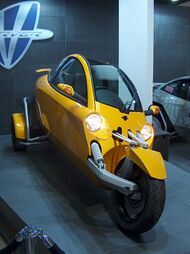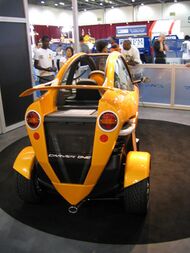Carver (automobile)
Topic: Engineering
 From HandWiki - Reading time: 5 min
From HandWiki - Reading time: 5 min
| Carver | |
|---|---|
 van den Brink-designed Carver One at full tilt (45°) going round a roundabout | |
| Overview | |
| Manufacturer | Carver |
| Also called | van den Brink |
| Production | 1999–2009 |
| Model years | 1999–2003 2003–2007 2007–2009 |
| Assembly | Germany |
| Designer | C.R. van den Brink and H.M. Kroonen |
| Body and chassis | |
| Class | Microcar |
| Body style | 1-door |
| Layout | Rear-engine, rear-wheel drive |
| Powertrain | |
| Engine | Turbocharged 4-stroke 660 cc (40 cu in) 16-valve inline-four |
| Transmission | 5-speed manual |
| Dimensions | |
| Length | 3,400 mm (11.2 ft) |
| Width | 1,300 mm (51 in) |
| Height | 1,400 mm (55 in) |
| uk|uk|Kerb|Curb}} weight | 640 kg (1,410 lb)[citation needed] |
The Carver is a tilting three-wheeled vehicle using an automatic balancing technology to balance the passenger compartment under all conditions. The first commercial Carver product, the Carver One, was designed to seat two people, and manufactured and distributed by Carver Europe (formerly named Vandenbrink) in the Netherlands. In June 2009 Carver Europe declared bankruptcy due to lack of demand at its 30,000 euro price, and ceased commercial production and sales.[1][2] (As of 2011), the technology is owned and licensed by Carver Technology.
Design and specification
The Carver vehicle combines aspects of a motorcycle and a car,[3] both in appearance and design. Like many microcars, the Carver has three wheels and the controls of a normal car. The three-wheel Carver One is said to have the comfort, controls and stability of a normal car while showing the dynamic[4] cornering behaviour of a motorcycle. The Carver was design with Man Wide Vehicles (MWVs)[5] in mind. The Carver can be driven by anyone with a normal car driver's license in the European Union, though other countries outside of the EU may not allow this. In most countries the taxation follows the motorcycle guidelines.
The dimensions are 3,400 mm (130 in) long by 1,300 mm (51 in) wide by 1,400 mm (55 in) high, giving it a low slim profile, similar to a motorcycle. It weighs 640 kg (1,410 lb),[citation needed] about half the weight of a medium size car or three to four times the weight of most motorcycles. The Carver One can tilt up to 45° while turning. This is not based on how far the steering wheel is rotated, but on how much cornering force is applied to it.
The Carver has a four-stroke 660 cc (40 cu in) 16-valve inline-four engine with an intercooled turbocharger, giving a power output of 65 bhp (48 kW)[citation needed] at 7,500 rpm and a maximum torque of 100 N⋅m (74 lbf⋅ft) at 4,000 rpm.[citation needed] The transmission is a 5-speed manual with reverse, and all wheels are equipped with ventilated disk brakes. The front wheel is slightly larger than the rear wheels (at 17" to 15").
The Carver One, as standard, has a top speed of 185 km/h (115 mph). The acceleration of 0–100 km/h in 8.2 seconds[6] (0 to 60 mph in 8 seconds).[7]
The Carver One was productionized[clarification needed] by Prodrive in the UK. The Carver One was assembled in Germany by ACÜ, part of the Mosolf Group, and officially launched at the Geneva Motor Show on 7 March 2007.
Dynamic Vehicle Control system
The unique property of the Carver One is its automatic balancing "Dynamic Vehicle Control" system, which is said[by whom?] to allow full stability under almost all circumstances. Thanks to this DVC technology its cornering behaviour is said to feel natural and pleasant.
In 2007 it was announced that a California company called Venture Vehicles would be producing the VentureOne, a vehicle using Carver's DVC system. The VentureOne was to be produced in three models: the e50 hybrid, the Q100 high performance hybrid, and the EV all electric.[8][9] In December 2008 Venture Vehicles was renamed Persu Mobility.[10][11] Persu Mobility continued to hold an exclusive license in North America to produce vehicles using the DVC system[12] and began pre-registration for a vehicle with an internal combustion engine called the Persu V3, to be available in 2014.[13] Persu has also planned future production of a plug-in hybrid.[14] The DVC system also is licensed to PAL-V who are developing a full-fledged flying and driving vehicle.[15] The DVC system has been demonstrated on a self-balancing ATV.[16]
Flying car
The PAL-V (Personal Air and Land Vehicle) is an autogyro developed from the Carver. It made its first flight in April 2012.[17][18]
Reception
The Carver One has been reviewed by various celebrities in various shows: In 2002 journalists Karl Tsigdinos and Conor Feehan got the chance to pilot the original Carver One on the ITV motoring program Drive!.[19]
On BBC's Top Gear programme in 2002, Jeremy Clarkson said, "I have to say, absolute hand on heart, I’ve never had so much fun in a car, really and truthfully, and I don’t think I’d ever tire of it."[20][21] Shortly thereafter the Carver One also featured in a special video of Jeremy Clarkson called "Shoot-out." He announced the vehicle to be "the most fun you can have."[22]
Jenson Button tested the Carver One in 2004.[23] "this car or bike or whatever you want to call it, is possibly the weirdest thing I have driven"
The Carvers have also starred in Sky Three "The Race" equipped with paint ball guns and driven by celebrities, and also Channel Fives "Gadget Show".
Most recently the Carver One featured on the intro to Amazon Prime's Grand Tour Season One Episode 5 Moroccan Roll, but did not feature in the show.
Version and variants
- Bug Carver (from 1999) – A carver with wing mirror at the top of the doors
- van den Brink Carver – Approx 24
- Carver One – Approx 200 sold around the world
- Ventura/Persu – USA
- phiaro p67b eternity – Japanese Styled
- Electric Carver – Lynx Cars Denmark
- PAL-V – Flying Car
- Helix Motors
- Chinese Sunra
- carver.earth
See also
- CLEVER – a similar BMW concept car
References
- ↑ TheMotorReport.com.au – Carver Declares Bankruptcy
- ↑ Carver Europe files for bankruptcy, technology may live on, Autoblog.com, June 30, 2009, http://green.autoblog.com/2009/06/30/carver-europe-files-for-bankruptcy-technology-may-live-on/, retrieved 2012-01-04
- ↑ Pauwelussen, JP. "The dynamic behaviour of man-wide vehicles with an automatic active tilting mechanism". http://www.narcis.nl/publication/RecordID/oai:tudelft.nl:uuid%3Afe1f237a-a6a5-44c6-acfa-f2d533c8ed99. Retrieved 6 December 2016.
- ↑ van den Brink, Chris. "Dynamic vehicle control for enclosed narrow vehicles". http://www.carver-technology.com/PDF/brink_EAEC_Cernobbio_1997.pdf. Retrieved 6 December 2016.
- ↑ van den Brink, CR. "Realization of high performance man wide vehicles (MWVs) with an automatic active tilting mechanism". http://www.carver-technology.com/PDF/brink_EAEC_Barcelona_1999.pdf. Retrieved 6 December 2016.
- ↑ Pauwelussen, JP. "The dynamic performance of narrow actively tilting vehicles". http://www.narcis.nl/publication/RecordID/oai:tudelft.nl:uuid%3Adb5a8470-51a8-4198-ba45-4907abcc9822.
- ↑ Driving.ca – It's a bike, it's a car, it's a ... Carver?
- ↑ VentureOne Tilting Trike
- ↑ Venture Vehicles to design and build 100 mpg three-wheeler
- ↑ VentureOne Review
- ↑ Venture Becomes Persu Mobility
- ↑ Persu Technology
- ↑ Persu V3 Pre-Registration
- ↑ [1]
- ↑ PAL-V website
- ↑ Video of self-balancing ATV with DVC technology
- ↑ Quick, Darren. "PAL-V flying car makes successful first test flight" GizMag.com, 2 April 2012. Retrieved 4 April 2012.
- ↑ Flying car makes maiden voyage (57 pictures) Washington Post, 3 April 2012. Retrieved 4 April 2012.
- ↑ Video of Drive! broadcast at YouTube
- ↑ "Series 2, Episode 9". Top Gear. Series 2. Episode 9. 13 July 2003. 40:24 minutes in. BBC Two.
I have to say, absolute hand on heart, I’ve never had so much fun in a car, really and truthfully, and I don’t think I’d ever tire of it.
- ↑ Video of TopGear broadcast at YouTube
- ↑ Video of Shoot-out, 2003
- ↑ Button and the Carver One at YouTube
External links
 KSF
KSF

